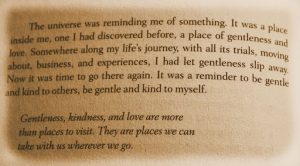I took the following themes away from the 2013 annual International Buddhism and Medicine conference, and would love to share them with you.
Whether we are patients, health professionals, or carers of loved ones, we all go through difficult life experiences and have difficult emotions to deal with. This is the common experience of all humanity, no matter where we come from, how privileged we are, or how good we are at our professions. We are all in this ‘soup’ of life together.
In caring for others, we have chosen to help to alleviate the suffering of the people who are in our care. New studies are showing that HOW we do this – the very spirit in which we do this – is the most important thing for us to be aware of, if we want to maximise both the benefit which people in our care derive, and also to ensure that we don’t burn out and can continue to be of good service.
Empathy v. Compassion
Recent studies show that when we empathise with another’s pain or suffering, we too take on that suffering, as if it were our own! Mirror neurones in the brain work so that what we witness is perceived as if it is actually happening to us. The Max Planck Institute for Human Cognitive and Brain Sciences in Leipzig, conducted a study in 2012 where EEGs – studies of brain activity – were taken of participants as they looked at distressing images of others in pain. The EEG’s showed that the parts of the participants’ brains relating to sorrow, pain and suffering lit up as they watched. This is the first time it has been clearly understood that when we identify with the suffering of others, that we are neurologically programmed to take it on as if it were our own.
When the same distressing images were shown to Tibetan monks as they also were doing compassion practices, researchers were surprised to discover that the part of their brain which was activated was not the same as in the previous group. In the monks, it was the frontal lobe which was activated, the region of the brain which correlates to kindness and joy and happiness.
The conclusions from this research are: when we make this subtle attitudinal shift from empathy to compassion, then the parts of our brain relating to happiness, love and kindness are activated, and the parts relating to the difficult experiences of pain and suffering are not.
So what is the difference then between empathy and compassion?
Empathy means that we enter into the other’s experience and feel the other’s suffering as if it were our own. For years empathy has been considered to be a key skill in all therapeutic inter-actions. It’s not that empathy is wrong, it is just that when we cultivate a compassionate attitude rather than simply an empathetic one, then something different happens in our brains.
Cultivating a compassionate attitude means that (rather than simply entering into the other’s experience) we take the time to hold the awareness of our common humanity and capacity for suffering, and cultivate a fervent and kind wish to help to alleviate the other’s suffering before and during all our interactions with our patients and/or loved ones ie. we take the time to set our intention to arouse compassion before any interaction and then consciously maintain a meta-awareness of that while we are with them.
It takes practice! It’s worth doing your own experiment. Try it, and notice the difference in how you feel at the end of an interaction with someone you are caring for.
Resilience = Capacity for Self-compassion
Another study at the University of Texas, looked at the parents of autistic children and showed that their resilience and capacity to cope with the difficult diagnosis of autism in their child, was more highly correlated to their capacity to be compassionate towards themselves, than it was to the degree of severity of the autism of their child.
This research shows that our resilience and capacity to deal with difficult circumstances in general, is more dependant on our capacity for self-compassion than it is on the severity of the external circumstances. Isn’t that fascinating? Our capacity to be kind to ourselves is the foundation of our ability to cope with the life experiences. If we can just teach our children this skill – both actively and by our own example – it will serve them for the rest of their lives…!
Sometimes, as carers, it’s more easy to find the capacity within to be compassionate to others, than it is to be compassionate to ourselves. However, it can make an enormous difference to all of us, if we can find that kind and compassionate part of ourselves and direct it, not just outwardly to the people we care for, but also inwardly to ourselves.
Compassion can be cultivated…
This is the good news, and yet another reason that meditation, particularly the compassion-based practices are so useful, because compassion for either ourselves or for others, can be cultivated. Meditation helps us do that…
When we do compassion practices, such as loving kindness meditations and others, we increase our own well-being, prevent burn-out and are more able to be present and useful to our clients or loved ones.
We just need to do it!
